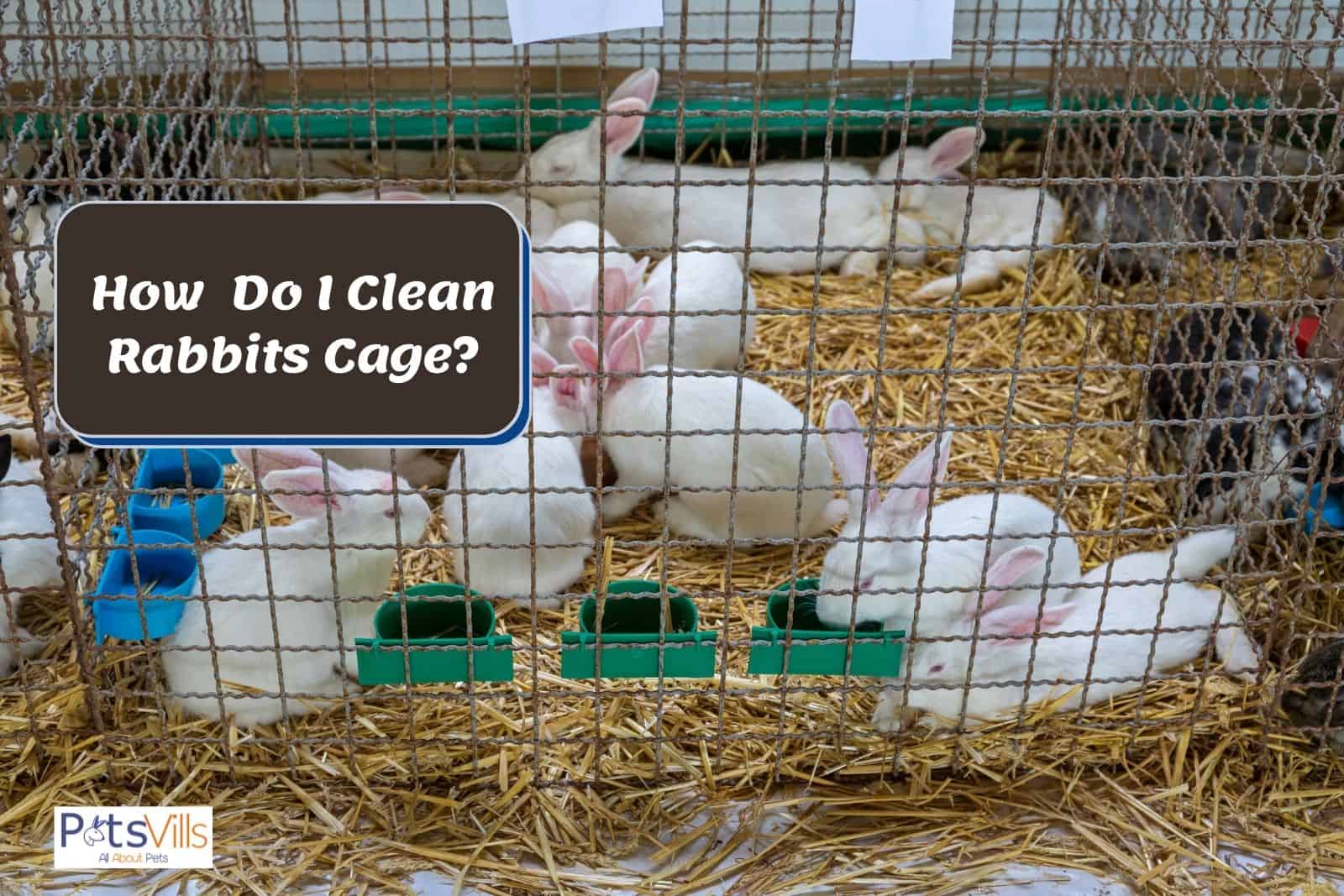If you are a first-time owner of a pet rabbit, you are probably still getting a hang of all the details that go into taking care of a rabbit.
One of the things you need to focus on is cleaning your rabbit’s cage or hutch. It is natural to wonder how often you should do it in order to keep the cage clean and your rabbit healthy.
How often should I clean my rabbit’s cage? You should thoroughly clean your rabbit’s cage once or twice a week. However, you should remove your rabbit’s droppings daily and remove any uneaten vegetables from its cage every couple of days.
Cleaning your rabbit’s cage or hutch once or twice a week is enough to keep its living environment fresh and prevent the spread of diseases in order to keep your bunny healthy and happy.
In this article, we will explain how to clean your rabbit’s cage and what cleaning products are safe to use.
Must-Read: Learn about the Holland lop bunnies
How Often Should I Clean My Rabbit’s Cage?
Rabbit cages and hutches require regular, thorough cleaning once or twice per week. When we say thorough cleaning, that includes using cleaning products to clean and disinfect the cage and replacing hay and bedding in the cage.
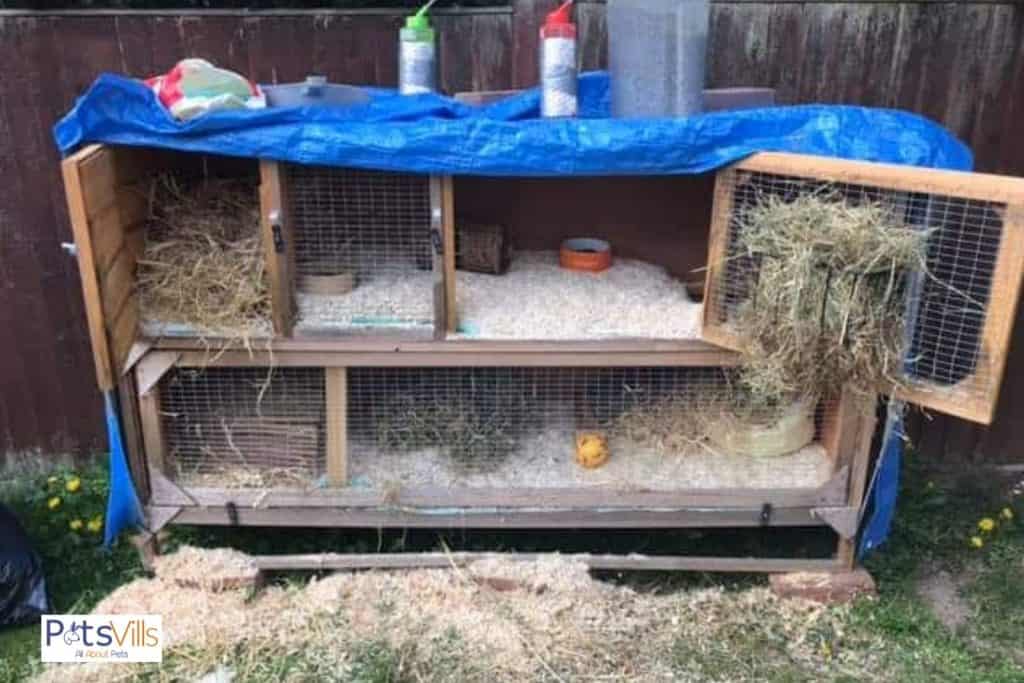
Keep in mind that cleaning your rabbit’s cage or hutch more than twice a week is not recommended nor it is necessary.
Cleaning the cage too often can be disruptive to your rabbit’s daily routine and it can make your rabbit stressed.
While thorough cleaning of the cage once or twice a week is enough, you should try to remove your rabbit’s droppings on a daily basis.
Spot cleaning can be very useful in these situations but even more, help can be to potty train your rabbit and teach it how to use a litter tray.
READ MORE: Are Bunnies Good Pets For Kids?
Why You Should Spot Clean
Spot cleaning means cleaning just the areas that are dirty on a regular basis, preferably every day. This is particularly important when it comes to cleaning your rabbit’s droppings.
When you spot clean, there is no need to remove things from the cage like you would do with a thorough, weekly cleaning.
Spot cleaning is not hard, especially when you figure out your rabbit’s toilet area.
Rabbits usually do their business in one spot and when you know where that spot is, you will be done in a matter of minutes.
If your rabbit is potty-trained and uses a litter box, then spot cleaning is even easier.
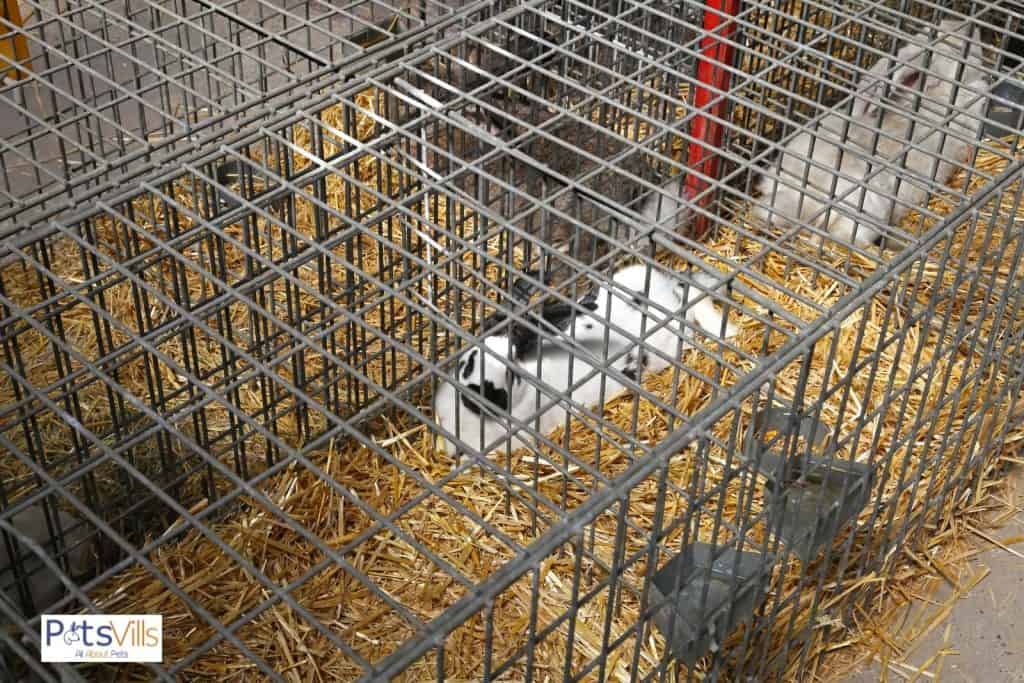
In addition to your rabbit’s droppings, you should also remove any uneaten food from the cage to prevent potential fungi or bacteria infestation.
You may not need to do this daily, but make sure to remove any uneaten vegetables every two or three days before they become rotten or moldy.
Wash out its food and water bowls and make sure that your rabbit has fresh water at all times.
Spot cleaning is enough to keep your rabbit’s cage or hutch clean enough and smelling fresh so you can do the thorough cleaning once or twice a week.
The main reason why spot cleaning is good comes from the fact that cleaning too often can cause stress for your rabbit.
After all, rabbits are creatures of habit and you would disrupt their routine by constantly getting them out of the cage to clean and taking out all the furnishing, bedding, and other belongings.
READ MORE: Do Rabbits Smell?
How Do I Clean My Rabbit’s Cage?
The first thing to do before you start thoroughly cleaning your rabbit’s cage is to get your rabbit out and put it in a safe place.
That will allow you to clean the cage without stressing your bunny or exposing it to any potentially harmful chemicals.
If your rabbit usually wanders around your home freely, let it hop around while you clean. If not, you need to put it in a secure area.
You may use another cage if you have it or if you don’t, you can use your bathtub. You can also give your bunny something to nibble on to keep it occupied, or let it play with one of its favorite chew toys.
Empty the Cage
Once you get your rabbit out of its cage or hutch, you need to remove everything from it in order to give it a thorough, deep cleaning.
Since you will clean both the interior and exterior of the cage, emptying the cage can make your job easier and allow you to clean more effectively.
Keep a trash bag handy and throw away any uneaten food, litter, hay, newspaper, or any other bedding. Empty the water bowl or bottle into the sink.
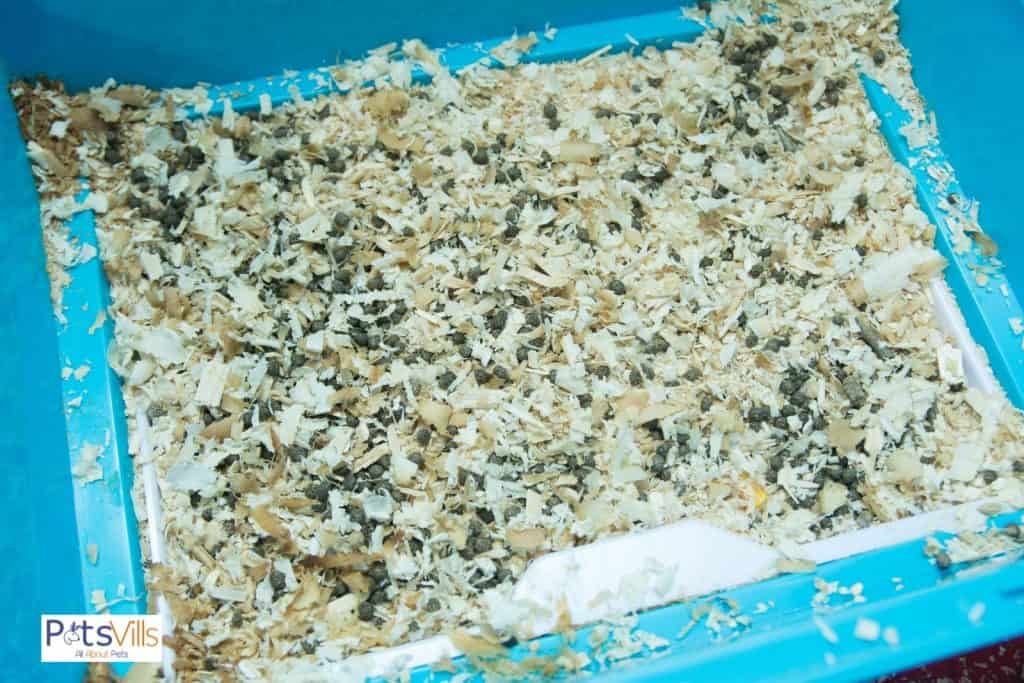
You can set aside the litter box, blankets, toys, food bowl, and other things you plan on putting back in the cage. Of course, you will first have to clean these items individually.
Clean the Cage Walls
Once you get everything out, you can start by cleaning the cage walls.
It is best to use a mixture of water and vinegar to disinfect the walls instead of commercial products since they can be harmful to your pet.
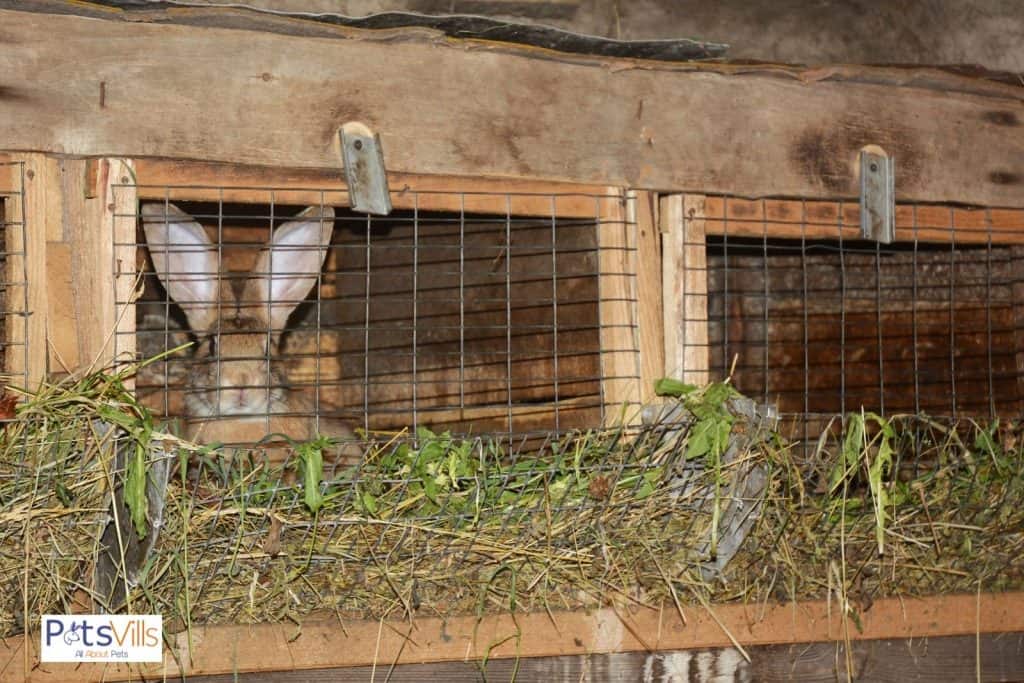
Wipe every wall of the cage carefully before you proceed to clean the floor and ceiling. Scrub the walls well to make sure that all stains are gone.
Make sure to wipe the walls clean after you scrub them to ensure no residue remains.
Leave the cage to dry completely before you put any items back in it, preferably in the sunshine if possible in order to prevent bacteria growth and to speed up the process.
Wash the Bedding
You can wash your rabbit’s blankets, sheets, or any other fabric you use as bedding for it in the washer.
Just remember to use hot water and unscented detergent so your rabbit’s skin doesn’t get exposed to harmful chemicals or harsh scents.
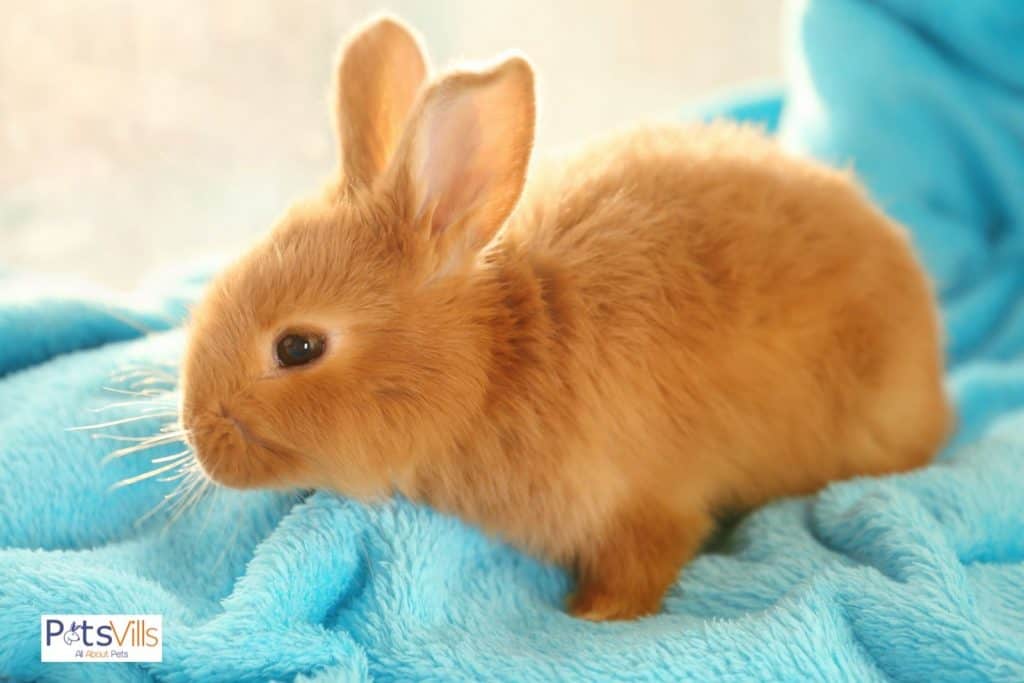
After you wash your rabbit’s bedding, make sure to properly dry it. This can help kill any bacteria and prevent moisture which can lead to illness.
Clean Food and Water Dishes
Even though you should clean your rabbit’s food and water dishes daily, you can give them a thorough cleaning as well once a week. After all, dirty food bowls are a perfect breeding ground for bacteria and fungi.
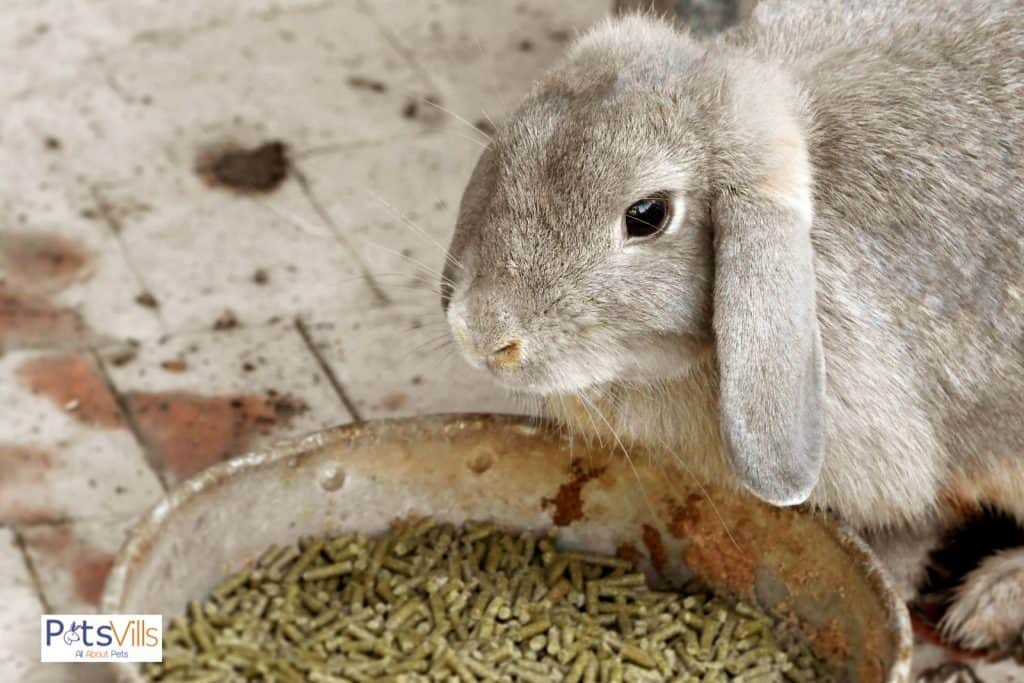
Wash the food and water bowls in hot and soapy water, or use a dishwasher if you have one.
You can also sterilize the bowls in boiling water. This will kill any bacteria and get rid of mildew or mold. Leave the dishes to dry completely before refilling them with water or food.
Soak the Litter Box
Your rabbit’s litter box has to be cleaned daily or it will spread odors and become a site for bacterial growth. In addition to this, you need to soak and wash the litter box thoroughly at least once a week.
To do this properly, you can use a mixture of water and vinegar to soak the litter box in it. This will clean any stains and disinfect the box.
To make the mixture, use four parts water and one part vinegar. Once the box has been soaked, rinse it with water and let it try properly before you refill it.
Clean or Replace Toys
Your rabbit’s toys can get dirty as well, just like the rest of the stuff in its cage. Inspect all of the plastic toys in the cage and don’t hesitate to throw away defective ones because they can harm your bunny.
The rest of its plastic toys should be washed with the same mixture of vinegar and water. Don’t forget to replace your rabbit’s paper toys as well, like paper boxes or telephone books.
Clean Around the Cage
Rabbits can be quite messy, so it is a good idea to clean the area around the cage or hutch.
Wipe any stains from the walls and floors around the cage and vacuum around the cage to ensure that both your rabbit’s living area and your home are clean and tidy.
Take a look at this video for an actual demonstration of how to keep a rabbit cage from smelling:
Be Careful What You Clean Your Rabbit’s Cage With
When you clean your rabbit’s cage, it is not advisable to use the same cleaning products you may use when you clean your home. These products often contain dangerous chemicals which can be harmful to your rabbit.
For example, you should definitely avoid bleach. This is especially true when you consider that a simple mixture of water and vinegar is enough to do the trick when it comes to cleaning and disinfecting your rabbit’s cage.
Another reason to avoid perfumed detergents comes from the fact that rabbits are extremely sensitive to smells so your bunny may become irritated when the scent of the detergent stays lingering on for days.
The Best Safe Rabbits Cage Cleaning Products You Should Use
As we already mentioned, avoid using your regular, commercial disinfectants and detergents to clean your rabbit’s cage.
It can be toxic to your bunny if you don’t rinse them well and it will certainly cost more than a simple mixture of water and vinegar.
In fact, vinegar is recommended by many experts because it can dissolve calcium salts that often precipitate out of the rabbit’s urine and create a hard material that sticks to the walls of the cage or the litter box.
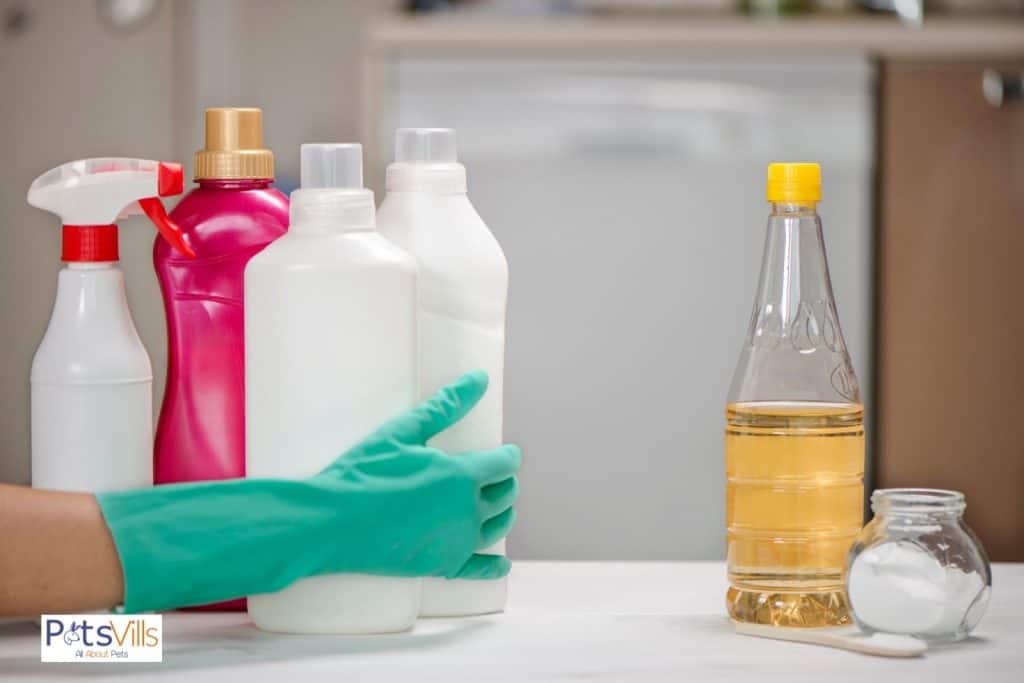
Of course, if you don’t want to use this mixture of water and vinegar, there are some products that are safe to use.
For example, you can use Nature’s Miracle Cage Cleaner to clean your rabbit’s cage or hutch. For your rabbit’s dishes, you can use Dawn Dish Soap.
In any case, whatever you decide to use, you will need to have your supplies ready if you want your cleaning to go smoothly. You will need a bucket, a stiff brush, a toothbrush for spots that are hard to reach, gloves, and a garbage bag.
Why Potty Training Your Rabbit is Useful
As we mentioned before, it is important to remove your rabbit’s droppings from the cage on a daily basis. This is something that can be done much easier if your rabbit is trained to use a litter box or tray. You will only have to clean the litter from the box in this case.
Usually, it isn’t really hard to potty train a rabbit since rabbits naturally do their business in one area of the cage anyway.
The first thing to do when you introduce the litter box or tray to your rabbit’s cage is to scoop up droppings and put them into the litter box.
This can often be enough for your rabbit to get the message and start using its new litter box.
If you want to learn how to potty train your pet, the video below is good to watch.
You can use various litter pellets and other products but you can also use any kind of paper or simply hay. While paper can be a good and affordable solution, it won’t help with odor control.
You also need to keep in mind that rabbits like to nibble on everything, including litter, so keep away from using toxic substances or clay-based litter which can get stuck in their digestive tract.
When you clean your rabbit’s litter box, check its urine and feces occasionally. This way, you can spot any changes which may indicate a potential health problem.
Additional Cleaning Tips
There are a few additional things you can do to make cleaning your rabbit’s cage easier:
- Choose a large cage or hutch because it will be easier to clean it.
- Make sure that you cover the floor of the cage with newspapers or hay to prevent urine and feces from getting stuck to the floor of your home.
- Go with absorbent bedding since it is much easier to change the bedding than scoop the mess from the floor of the cage.
- Spay or neuter your rabbit to reduce territorial spraying and marking.
FAQs
What type of bedding is best for rabbits?
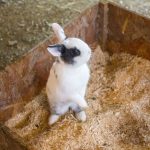
The most common choice of bedding for rabbits includes wood showings or sawdust. However, studies have shown that this can lead to liver disease, so it is better to go with paper pulp bedding like Carefresh or to use wood pellets, straw or hay.
What should a rabbit’s droppings look like?
Your rabbit’s droppings can tell you a lot about its health. A healthy rabbit will have droppings that are uniform in shape and size. That means that they should be rounded and pea-sized, although some rabbits leave larger droppings.
How do I stop my rabbit cage from smelling?
Spot cleaning your rabbit cage every day or two and a deep clean weekly will keep your rabbits cage from smelling.
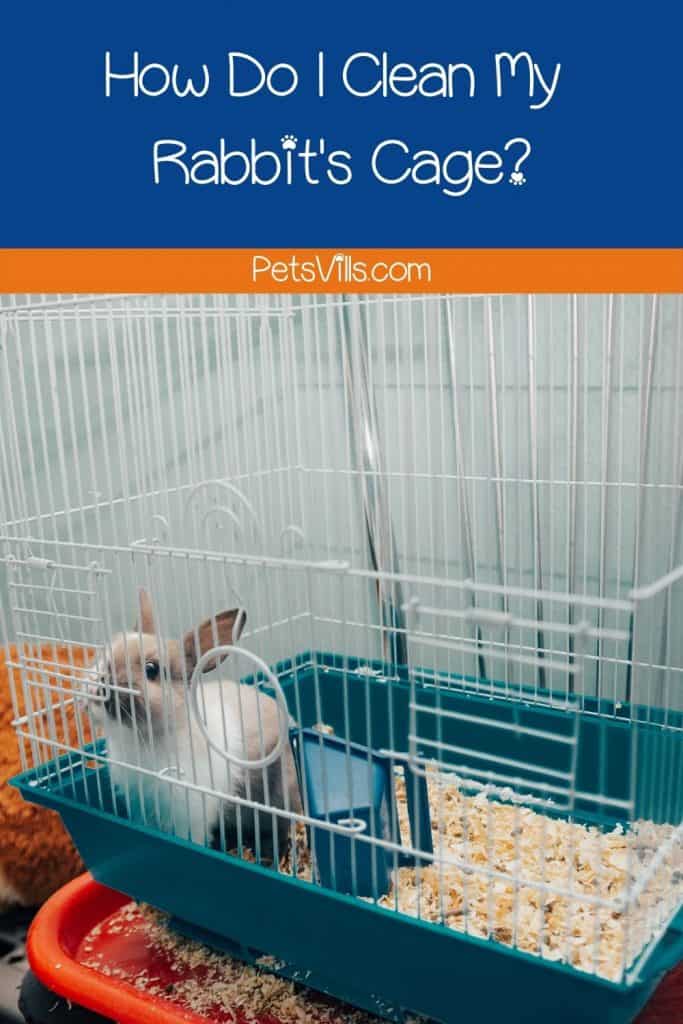
If you have more tips for cleaning the rabbits’ cage, let me know in the comments below!
Barry Stingmore is a British content writer living in Fuerteventura, Spain. An animal lover at heart, he shares his home with a dog and four rescue cats and has a passion for writing about animals big and small.
Barry loves finding answers to your animal-related questions, the more research involved the better! You can rely on him to find the facts.
Find him on FACEBOOK, TWITTER AND Linkedin
Read his latest ARTICLES.
Find more about him HERE.

